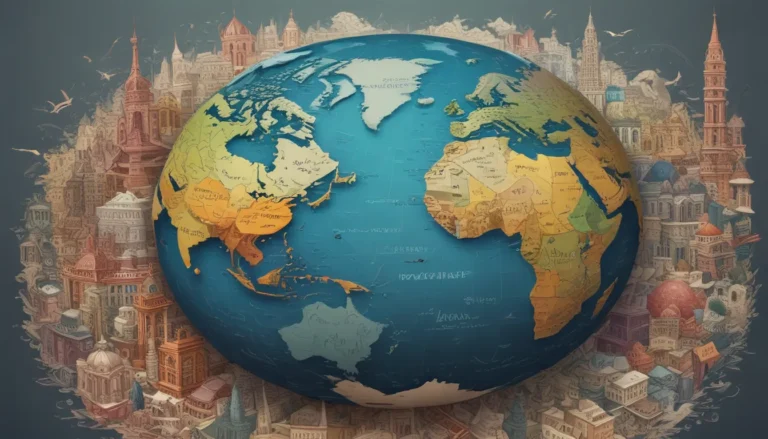A Note About Images: The images used in our articles are for illustration purposes only and may not exactly match the content. They are meant to engage readers, but the text should be relied upon for accurate information.
In our fast-paced world, the impact of human actions on the environment has become increasingly visible. From deforestation to pollution, the delicate balance of our ecosystems is at risk. It is crucial to understand the gravity of this issue to find sustainable solutions for the future. In this article, we will delve into fascinating facts about environmental degradation to shed light on the crisis we are facing and inspire positive changes in our lives and our communities.
The Impact of Environmental Degradation
Environmental degradation encompasses various harmful processes that affect our planet’s health and future. By taking action to protect our environment and promote sustainable practices, we can work towards a healthier and greener planet for generations to come. Climate change, pollution, habitat loss, and loss of biodiversity are all symptoms of environmental degradation, highlighting the urgent need for collective efforts to address these challenges.
Land Degradation: A Visible Consequence
Land degradation, including deforestation and soil erosion, is a visible and concerning form of environmental degradation. It not only impacts the productivity of agricultural lands but also leads to habitat loss for numerous species. Recognizing the importance of preserving our land is crucial in mitigating the effects of environmental degradation.
Climate Change: A Contributing Factor
The exacerbation of environmental degradation is closely linked to climate change. Rising temperatures and changing weather patterns have led to melting polar ice caps, rising sea levels, and more frequent natural disasters. Addressing climate change is essential in reversing the damaging effects of environmental degradation on our planet.
Water Pollution: A Growing Threat
Pollution from industrial waste, agricultural runoff, and plastic waste poses a significant threat to aquatic ecosystems. It endangers marine life, compromises clean water availability, and requires urgent attention to prevent further degradation of our water resources.
Air Pollution: Impacting Human Health
Air pollution, caused by industrial emissions, vehicle exhaust fumes, and fossil fuel burning, has severe implications for human health. Respiratory problems, cardiovascular diseases, and premature death are all consequences of air pollution. Sustainable solutions are needed to combat this harmful aspect of environmental degradation.
Deforestation: A Critical Issue
Deforestation, driven by agriculture, logging, and urbanization, not only results in habitat loss but also contributes to climate change by reducing carbon dioxide absorption. Protecting our forests is essential in addressing environmental degradation and preserving biodiversity.
Overfishing: Threatening Marine Life
Unsustainable fishing practices, such as overfishing and destructive methods, deplete fish populations, disrupt marine ecosystems, and jeopardize the livelihoods of coastal communities. Sustainable fishing practices are crucial in preserving marine biodiversity and ecosystems.
Urbanization: Alarming Habitat Loss
Rapid urbanization leads to the encroachment on natural habitats, resulting in fragmented ecosystems and wildlife displacement. Balancing urban development with conservation efforts is key to mitigating the negative effects of urbanization on our environment.
Chemical Pollution: Environmental Risks
The release of pollutants, such as pesticides and industrial chemicals, into the environment poses risks to ecosystem health and human well-being. Contaminated soil, water, and air can have long-lasting detrimental effects, emphasizing the need for stringent regulations and sustainable practices.
Loss of Biodiversity: A Consequence of Degradation
The destruction of habitats and the introduction of invasive species contribute to the loss of biodiversity, impacting ecosystem stability and resilience. Preserving biodiversity is crucial in maintaining the balance of our ecosystems and safeguarding the planet’s future.
Ozone Layer Depletion: A Global Concern
The thinning of the ozone layer, caused by chemicals like chlorofluorocarbons (CFCs), leads to increased UV radiation reaching the Earth’s surface. This poses risks to ecosystems and human health, highlighting the importance of addressing ozone layer depletion in environmental conservation efforts.
Carbon Emissions: Driving Climate Change
Greenhouse gases, primarily carbon dioxide, released from human activities like fossil fuel burning and deforestation, contribute significantly to climate change and environmental degradation. Reducing carbon emissions is essential in mitigating the effects of climate change on our planet.
Plastic Pollution: A Worldwide Challenge
The widespread use of single-use plastics and inadequate waste management practices have resulted in a massive accumulation of plastic waste in our landfills and oceans. This poses a grave threat to marine life and ecosystems, necessitating urgent action to address plastic pollution.
Soil Erosion: Threatening Food Security
Unsustainable farming practices and deforestation contribute to soil erosion, reducing soil fertility and agricultural productivity. Protecting our soils and promoting sustainable agriculture are essential in ensuring global food security and combating environmental degradation.
Environmental Justice: Addressing Inequality
Vulnerable communities, often low-income and marginalized groups, bear the brunt of environmental degradation. Limited resources and exposure to high pollution levels make them more susceptible to the harmful effects of environmental degradation. Promoting environmental justice is key in creating a more equitable and sustainable future for all.
Conclusion: A Call to Action
Environmental degradation is a complex issue that requires collective action to address. By adopting sustainable practices, supporting conservation efforts, and advocating for policies that prioritize the environment, we can work towards a greener and more sustainable future. Every small action counts in the fight against environmental degradation, and together, we can make a positive impact on our planet.
FAQs: Common Questions Answered
Q: What is environmental degradation?
A: Environmental degradation refers to the deterioration of the natural environment due to human activities such as pollution, deforestation, and habitat destruction.
Q: What are the main causes of environmental degradation?
A: Industrialization, improper waste management, overexploitation of natural resources, and unsustainable agricultural practices are among the main causes of environmental degradation.
Q: How does environmental degradation affect humans?
A: Environmental degradation can impact human health through air and water pollution, exposure to toxic substances, loss of biodiversity, and climate change.
Q: What can individuals do to combat environmental degradation?
A: Individuals can reduce water and energy consumption, practice recycling, support sustainable agriculture, use eco-friendly transportation, and advocate for environmental protection policies.
Q: How can governments address environmental degradation?
A: Governments can address environmental degradation by implementing environmental regulations, supporting renewable energy sources, investing in sustainable infrastructure, and raising awareness through education campaigns.
Environmental degradation is a global challenge that requires immediate attention and collective action. By understanding the causes and consequences of environmental degradation, we can work towards building a sustainable future for ourselves and future generations. Let’s take steps today to protect our planet and preserve its beauty and resources for years to come.






